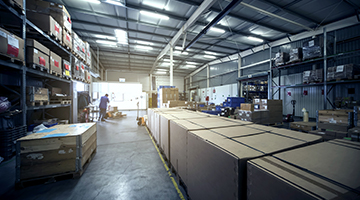Resources
5 Ways to Reduce Costs Through Energy Efficiency in Warehouse and Office Space
Energy efficiency, especially in a large warehouse or office settings, helps to protect the environment while also cutting spending on energy consumption. With provincial and federal government incentives currently being made available to businesses that are willing to replace inefficient products or incorporate green systems, now is the perfect time to refit or renovate a property in order to boost efficiency and, ultimately, budget savings.

1. Lighting
The effect of efficient lighting in warehouses cannot be understated. Practical first steps to reducing energy waste involved with lighting include the installation of automatic dimmers and switches. When a warehouse or office space is unoccupied there’s no reason to let it remain lit. Motion sensors and timers both do an excellent job of making sure that light isn’t being wasted in unused areas. Peripheral lighting can also help to save on light-related costs. Current technology allows for customizable lighting schematics that can switch off peripheral lights during the day or in the time following normal hours of operation.
High efficiency lamps are another smart step toward increasing efficiency. The initial cost of purchasing and installing highly efficient, compact fluorescent bulbs may look daunting but an overall electricity consumption cut of 75% (without any reduction in illumination itself) will result in long-term savings on hydro bills. Replacing older fixtures with new ones coated in silver, aluminum or multiple dielectric can also better distribute light in order to cut down on electricity usage. If your warehouses or offices have yet to be occupied (or could benefit from extra attention) consider applying light paint colours. Darker tones actually absorb illumination and, over time, can cause unnecessary spending on hydroelectricity whereas lighter shades create the opposite effect.
Lighting and air systems can be combined in many open-plan warehouses as well. These integrated systems are able to gather some light energy from fixtures and put it to use in circulation, cutting back on unnecessary waste and spending.

2. Air
Air circulation systems are another of the most important areas of any warehouse or office setting. Temperature settings should be carefully regulated (ideally between 23 and 25 degrees Celsius) so that cooling and/or heating systems aren’t being activated unnecessarily. Humidity settings should also be monitored in order to increase efficiency. Maintaining a relative humidity of 55% to 65% will ensure a comfortable working environment without causing air and water circulation systems to expend wasted energy.
Chilled water used in air conditioning technology can also be regulated and should be kept at roughly 7 degrees Celsius (leaving temperature) for optimal efficiency. Lastly, fan speed (especially in large warehouses where offsetting the production of heat from machinery may be a concern) should have frequency converters installed. The use of a quality frequency converter has been shown to save on fan motor energy consumption by approximately 15%.

3. Windows and Doors
Ensuring that windows and doors are properly insulated and weather-stripped helps to boost energy efficiency as well. By working to keep cold or hot air from escaping into or out of a warehouse or office space, quality insulation and seals can minimize the work of air circulation systems and better maintain a proper temperature inside. Weatherstripping windows and doors is a simple and fairly low-cost step toward long-term savings.
Installing self-closing doors and reminding employees to close large entrance/exit sites (like loading bay shutters) also helps to reduce temperature differentials, cutting down on the bottom line of energy costs.

4. Building Materials
The use of proper building materials should also be looked into when leasing or building a warehouse. Roofing is one of the prime areas of construction that can work to maintain an energy efficient building. Most warehouses, constructed relatively recently, will already have black EPDM rubber or white thermoplastic polyolefin roofing membranes in order to absorb heat from the sun. Companies with the appropriate budget can look into installing solar panels on warehouse roofs as well. The savings made possible through a switch to natural energy can be tremendous for any company that has the finances to carry the initial materials and installation investment.
Industrial concrete coating can be used to boost efficiency while also improving the appearance of a warehouse’s exterior as well. Modern concrete coatings are able to better insulate a building and stop heat or cool air from escaping or entering.

5. Maintenance
Regular maintenance of energy-related appliances and products goes a long way toward ensuring that no energy is being consumed where it could be avoided. Plumbing systems are one, extremely important feature of any building that should be kept in proper condition. Water pipe insulation (particularly for chilled water pipes) can take an enormous toll on energy output and large water boilers or storage tanks, when leaking, are capable of wasting an enormous amount of both money and natural resources. Hiring a professional service to mechanically clean water pipes and appliance tubing allows businesses to ward off many problems associated with improperly functioning systems.
Clean, optimally functioning air filters are also able to work better in transferring heat between water and air systems, reducing unnecessary energy expenditure. Even the simple act of dusting light fixtures or cleaning debris from air ducts/filters several times a year can work to reduce energy consumption in a noticeable way.





